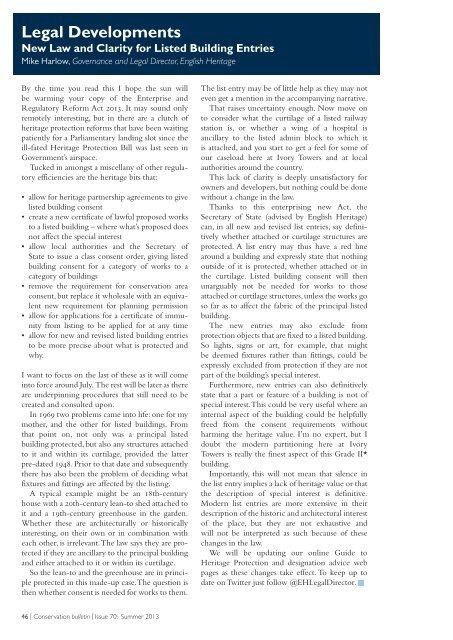Conservation Bulletin 70 | PDF - English Heritage
Conservation Bulletin 70 | PDF - English Heritage
Conservation Bulletin 70 | PDF - English Heritage
You also want an ePaper? Increase the reach of your titles
YUMPU automatically turns print PDFs into web optimized ePapers that Google loves.
BUILDING MATERIALS<br />
Legal Developments<br />
New Law and Clarity for Listed Building Entries<br />
Mike Harlow, Governance and Legal Director, <strong>English</strong> <strong>Heritage</strong><br />
By the time you read this I hope the sun will<br />
be warming your copy of the Enterprise and<br />
Regulatory Reform Act 2013. It may sound only<br />
remotely interesting, but in there are a clutch of<br />
heritage protection reforms that have been waiting<br />
patiently for a Parliamentary landing slot since the<br />
ill-fated <strong>Heritage</strong> Protection Bill was last seen in<br />
Government’s airspace.<br />
Tucked in amongst a miscellany of other regulatory<br />
efficiencies are the heritage bits that:<br />
• allow for heritage partnership agreements to give<br />
listed building consent<br />
• create a new certificate of lawful proposed works<br />
to a listed building – where what’s proposed does<br />
not affect the special interest<br />
• allow local authorities and the Secretary of<br />
State to issue a class consent order, giving listed<br />
building consent for a category of works to a<br />
category of buildings<br />
• remove the requirement for conservation area<br />
consent, but replace it wholesale with an equivalent<br />
new requirement for planning permission<br />
• allow for applications for a certificate of immunity<br />
from listing to be applied for at any time<br />
• allow for new and revised listed building entries<br />
to be more precise about what is protected and<br />
why.<br />
I want to focus on the last of these as it will come<br />
into force around July. The rest will be later as there<br />
are underpinning procedures that still need to be<br />
created and consulted upon.<br />
In 1969 two problems came into life: one for my<br />
mother, and the other for listed buildings. From<br />
that point on, not only was a principal listed<br />
building protected, but also any structures attached<br />
to it and within its curtilage, provided the latter<br />
pre-dated 1948. Prior to that date and subsequently<br />
there has also been the problem of deciding what<br />
fixtures and fittings are affected by the listing.<br />
A typical example might be an 18th-century<br />
house with a 20th-century lean-to shed attached to<br />
it and a 19th-century greenhouse in the garden.<br />
Whether these are architecturally or historically<br />
interesting, on their own or in combination with<br />
each other, is irrelevant.The law says they are protected<br />
if they are ancillary to the principal building<br />
and either attached to it or within its curtilage.<br />
So the lean-to and the greenhouse are in principle<br />
protected in this made-up case.The question is<br />
then whether consent is needed for works to them.<br />
The list entry may be of little help as they may not<br />
even get a mention in the accompanying narrative.<br />
That raises uncertainty enough. Now move on<br />
to consider what the curtilage of a listed railway<br />
station is, or whether a wing of a hospital is<br />
ancillary to the listed admin block to which it<br />
is attached, and you start to get a feel for some of<br />
our caseload here at Ivory Towers and at local<br />
authorities around the country.<br />
This lack of clarity is deeply unsatisfactory for<br />
owners and developers, but nothing could be done<br />
without a change in the law.<br />
Thanks to this enterprising new Act, the<br />
Secretary of State (advised by <strong>English</strong> <strong>Heritage</strong>)<br />
can, in all new and revised list entries, say definitively<br />
whether attached or curtilage structures are<br />
protected. A list entry may thus have a red line<br />
around a building and expressly state that nothing<br />
outside of it is protected, whether attached or in<br />
the curtilage. Listed building consent will then<br />
unarguably not be needed for works to those<br />
attached or curtilage structures, unless the works go<br />
so far as to affect the fabric of the principal listed<br />
building.<br />
The new entries may also exclude from<br />
protection objects that are fixed to a listed building.<br />
So lights, signs or art, for example, that might<br />
be deemed fixtures rather than fittings, could be<br />
expressly excluded from protection if they are not<br />
part of the building’s special interest.<br />
Furthermore, new entries can also definitively<br />
state that a part or feature of a building is not of<br />
special interest.This could be very useful where an<br />
internal aspect of the building could be helpfully<br />
freed from the consent requirements without<br />
harming the heritage value. I’m no expert, but I<br />
doubt the modern partitioning here at Ivory<br />
Towers is really the finest aspect of this Grade II*<br />
building.<br />
Importantly, this will not mean that silence in<br />
the list entry implies a lack of heritage value or that<br />
the description of special interest is definitive.<br />
Modern list entries are more extensive in their<br />
description of the historic and architectural interest<br />
of the place, but they are not exhaustive and<br />
will not be interpreted as such because of these<br />
changes in the law.<br />
We will be updating our online Guide to<br />
<strong>Heritage</strong> Protection and designation advice web<br />
pages as these changes take effect. To keep up to<br />
date on Twitter just follow @EHLegalDirector. ■<br />
46 | <strong>Conservation</strong> bulletin | Issue <strong>70</strong>: Summer 2013

















